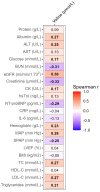Low Valine Serum Levels Predict Increased 1-Year Mortality in Acute Heart Failure Patients
- PMID: 37759723
- PMCID: PMC10527293
- DOI: 10.3390/biom13091323
Low Valine Serum Levels Predict Increased 1-Year Mortality in Acute Heart Failure Patients
Abstract
Considering the relationship between disease severity and the extent of metabolic derangement in heart failure, we hypothesized that the serum levels of metabolites may have prognostic value for 1-year mortality in acute heart failure (AHF). The AHF study was a prospective, observational study enrolling consecutive patients hospitalized due to AHF. Metabolites were measured in serum collected at admission using NMR spectroscopy. Out of 315 AHF patients, 118 (37.5%) died within 1 year after hospitalization for AHF. The serum levels of 8 out of 49 identified metabolites were significantly different between patients who were alive and those who died within 1 year after hospitalization for AHF. Of these, only valine was significantly associated with 1-year mortality (hazard ratio 0.73 per 1 standard deviation increase, 95% confidence interval: 0.59-0.90, p = 0.003) in the multivariable Cox regression analyses. Kaplan-Maier analysis showed significantly higher survival rates in AHF patients with valine levels above the median (>279.2 µmol/L) compared to those with valine levels ≤ 279.2 µmol/L. In a receiver operating characteristics curve analysis, valine was able to discriminate between the two groups with an area under the curve of 0.65 (95% CI 0.59-0.72). We conclude that valine serum levels might be of prognostic value in AHF.
Keywords: NMR spectroscopy; acute heart failure; metabolomics; mortality; prognostic biomarkers; risk; valine.
Conflict of interest statement
The authors declare no conflict of interest.
Figures





Similar articles
-
Circulating miR-30d Predicts Survival in Patients with Acute Heart Failure.Cell Physiol Biochem. 2017;41(3):865-874. doi: 10.1159/000459899. Epub 2017 Feb 16. Cell Physiol Biochem. 2017. PMID: 28214846 Free PMC article. Clinical Trial.
-
Serum Irisin Predicts Mortality Risk in Acute Heart Failure Patients.Cell Physiol Biochem. 2017;42(2):615-622. doi: 10.1159/000477867. Epub 2017 Jun 9. Cell Physiol Biochem. 2017. PMID: 28595171
-
Prognostic Significance of Serum Cysteine-Rich Protein 61 in Patients with Acute Heart Failure.Cell Physiol Biochem. 2018;48(3):1177-1187. doi: 10.1159/000491984. Epub 2018 Jul 25. Cell Physiol Biochem. 2018. PMID: 30045012
-
Metabonomics analysis of plasma reveals the lactate to cholesterol ratio as an independent prognostic factor of short-term mortality in acute heart failure.PLoS One. 2013;8(4):e60737. doi: 10.1371/journal.pone.0060737. Epub 2013 Apr 3. PLoS One. 2013. PMID: 23573279 Free PMC article.
-
Long-term survival after hospitalization for acute heart failure--differences in prognosis of acutely decompensated chronic and new-onset acute heart failure.Int J Cardiol. 2013 Sep 20;168(1):458-62. doi: 10.1016/j.ijcard.2012.09.128. Epub 2012 Oct 13. Int J Cardiol. 2013. PMID: 23073273
Cited by
-
Branched-Chain Amino Acids, Alanine, and Thyroid Function: A Cross-Sectional, Nuclear Magnetic Resonance (NMR)-Based Approach from ELSA-Brasil.Metabolites. 2024 Aug 6;14(8):437. doi: 10.3390/metabo14080437. Metabolites. 2024. PMID: 39195533 Free PMC article.
References
Publication types
MeSH terms
Substances
Grants and funding
LinkOut - more resources
Full Text Sources
Medical

